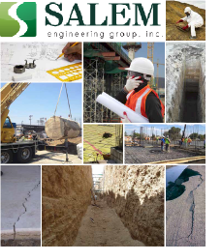SALEM Engineering Group, Inc.’s multi-state registered Professional Engineers are well known for the creative design work that utilizes Value Engineering solutions in the original design. SALEM Engineering Group, Inc. works closely with the design team including Architects, Engineers and Contractors for the most feasible design that works great during construction and project completion. SALEM Engineering Group, Inc. takes great pride in the original design work and engineering calculations by working closely with each jurisdiction to avoid lengthy plan check items.
SALEM Engineering Group, Inc.’s Structural Engineering Team has experience in projects ranging from single-family residential projects to large multi-use high rise structures. SALEM Engineering Group, Inc.’s team will be with you from the beginning of design, during construction and even after the project successfully completed.
Feasibility Studies
A feasibility study is used when evaluating different options and alternatives for a project or when evaluating a project for a quick “go” or “no-go” decision. A feasibility study is performed at the earliest stages of a project, as part of a preliminary design and scope development, to help determine if a project is possible within given constraints (time, budget, scope). SALEM Engineering Group, Inc. can perform pre-feasibility studies (assessing project requirements and desired features), feasibility studies, preliminary plans and conceptual drawings, as well as developing full construction plans and specifications.
Foundation Design
Many different types of foundation systems are available for construction. Our goal is to create a foundation design that is feasible to accommodate any site specific constraints and keep it cost-effective. Our typical design consists of either Shallow or Deep Foundations. Shallow Foundations often are usually embedded about two feet or so into soil. One common type is the spread footing, which consists of strips or pads of concrete which extend below the frost line and transfer the weight from walls and columns to the soil or bedrock. Another common type of shallow foundation is the slab-on-grade foundation where the weight of the structure is transferred to the soil through a concrete slab placed at the surface. Slab-on-grade foundations can be reinforced slabs, which range from 4 inches to several feet thick, depending on the size of the building, or post-tensioned slabs, which are typically at least 12 inches for houses, and thicker for heavier structures. Deep Foundation is used to transfer the load of a structure down through the upper weak layer of topsoil to the stronger layer of subsoil below. There are different types of deep footings including impact driven piles, drilled shafts, caissons, helical piles, geo-piers and earth stabilized columns.
Gravity Analysis / Roof Design
A roof system is a key structural and architectural feature of a building. The roof system will affect the cost of construction, the interior and exterior building ambiance, the building maintenance, and the cost of operating the building. Wood and steel trusses, concrete (cast-in-place or precast), glulam beams, bar joists, space frames and other options are available for roof designs. SALEM Engineering Group, Inc. will work with the design team to provide code compliant roof designs that meet the needs of the project owner.
Structural Steel Design
There are currently two common methods of steel design: The first method is the Allowable Strength Design (ASD) method. The second is the Load and Resistance Factor Design (LRFD) method. Both use a strength, or ultimate level design approach. SALEM Engineering Group, Inc. utilizes both methods to determine the most feasible approach whether it’s for Gravity Loads or Lateral Loads. SALEM Engineering Group, Inc. can design for Beams, Columns and Concentrically Braced Frames with excellent details for connections of both High Strength Bolts and Welds.
Structural Wood Design
Like structural steel, wood may be designed using ASD, LFRD or the conventional light frame construction provisions as per the IBC and National Design Specifications for Wood Construction. SALEM Engineering Group, Inc. routinely designs for construction classifications III, IV and V.
Reinforced Concrete Design
Concrete by itself, is great for resisting forces in compression, Reinforced Concrete (RC) with steel reinforcing bars (rebar) and is usually embedded passively in the concrete before the concrete sets to strengthen the forces resisting in tension. Reinforcing schemes are generally designed to resist tensile stresses in particular regions of the concrete that might cause unacceptable cracking and/or structural failure. SALEM Engineering Group, Inc. can design for both pre-tensioning and post-tensioning. SALEM Engineering Group, Inc. design team understands for a strong, ductile and durable construction the reinforcement needs to have the following properties at least; High relative strength, high toleration of tensile strain, good bond to the concrete, irrespective of pH, moisture, and similar factors, thermal compatibility, not causing unacceptable stresses in response to changing temperatures.
Masonry Structure Design
Whether you need a Retaining Wall Design or a Special Reinforced Masonry Structure, SALEM Engineering Group, Inc. has vast experience in Bearing Wall Systems, Building Frame Systems and Dual Systems. Contact us for more information.
Engineering Calculations
Engineering calculations are needed for all but the most simple of projects. Some projects, such as wood-framed single-family homes can be designed and permits obtained using building code minimums and frame sizing and spacing from code tables. Engineering calculation can be performed by hand, by computer or by using a combination of these methods. Knowing the design requirements, loading conditions and intended use of the structure are essential in performing and evaluating the appropriateness of the results of calculations. Calculations are often an interactive process, where different sizes and configurations are tried to fit into the available space and to provide the most economical and safe design. Calculations are performed to support the design drawings and are presented to the building official to obtain permits.
Structural Inspections & Quality Control
SALEM Engineering Group, Inc. has many Registered Engineers and Special Inspectors that can perform Structural Inspection/Observation to verify the structure is built as per the general conformance to the approved construction documents at significant construction stages and at completion of the structural system.
Failure Analysis
Structural failure is a state where a structure can no longer fulfill its intended purpose. This can be a result of a partial or total collapse, or from over-stressing of structural components beyond code allowed limits without collapse. Failure can be caused by fire, wind, impact, flooding, earth movement or other environmental or physical conditions. Failure can also result from deterioration of construction materials. SALEM Engineering Group, Inc.’s team of Professional Engineers can assess the condition of the building, perform needed materials testing to verify as-built conditions and prepare calculations and analysis to determine the present factor of safety and structural condition of the structure. Based on the results of the failure analysis, options can be recommended to re-inforce or repair the structure and bring it into code compliance.
Related Services

Forensic Engineering
SALEM has a professional relationship with several national insurance …

Construction Inspection & Material Testing
SALEM Engineering Group, Inc. offers an extensive array of construction …

Geotechnical Engineering
SALEM Engineering Group, Inc. offers a wide range of geotechnical …

Civil Engineering Design & Land Surveying
SALEM Engineering Group, Inc. has proudly developed a client …


